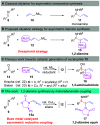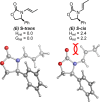Access to Chiral Diamine Derivatives through Stereoselective Cu-Catalyzed Reductive Coupling of Imines and Allenamides
- PMID: 33724828
- PMCID: PMC8025098
- DOI: 10.1021/acs.joc.0c02971
Access to Chiral Diamine Derivatives through Stereoselective Cu-Catalyzed Reductive Coupling of Imines and Allenamides
Abstract
Chiral 1,2-diamino compounds are important building blocks in organic chemistry for biological applications and as asymmetric inducers in stereoselective synthesis that are challenging to prepare in a straightforward and stereoselective manner. Herein, we disclose a cost-effective and readily available Cu-catalyzed system for the reductive coupling of a chiral allenamide with N-alkyl substituted aldimines to access chiral 1,2-diamino synthons as single stereoisomers in high yields. The method shows broad reaction scope and high diastereoselectivity and can be easily scaled using standard Schlenk techniques. Mechanistic investigations by density functional theory calculations identified the mechanism and origin of stereoselectivity. In particular, the addition to the imine was shown to be reversible, which has implications toward development of catalyst-controlled stereoselective variants of the identified reductive coupling of imines and allenamides.
Conflict of interest statement
The authors declare no competing financial interest.
Figures












Similar articles
-
An advance on exploring N-tert-butanesulfinyl imines in asymmetric synthesis of chiral amines.Acc Chem Res. 2008 Jul;41(7):831-40. doi: 10.1021/ar7002623. Epub 2008 Jun 6. Acc Chem Res. 2008. PMID: 18533688
-
Catalytic Asymmetric Imine Cross-Coupling Reaction.J Am Chem Soc. 2023 Mar 1;145(8):4400-4407. doi: 10.1021/jacs.3c00051. Epub 2023 Feb 17. J Am Chem Soc. 2023. PMID: 36800284
-
Enantioselective Synthesis of anti-1,2-Diamines by Cu-Catalyzed Reductive Couplings of Azadienes with Aldimines and Ketimines.J Am Chem Soc. 2018 Jun 13;140(23):7083-7087. doi: 10.1021/jacs.8b04750. Epub 2018 May 30. J Am Chem Soc. 2018. PMID: 29775301 Free PMC article.
-
Synthesis of fluorinated chiral amines using N-tert-butylsulfinyl imines.Future Med Chem. 2009 Aug;1(5):875-88. doi: 10.4155/fmc.09.62. Future Med Chem. 2009. PMID: 21426086 Review.
-
Recent advances in imine reductase-catalyzed reactions.World J Microbiol Biotechnol. 2017 Oct 11;33(11):199. doi: 10.1007/s11274-017-2365-8. World J Microbiol Biotechnol. 2017. PMID: 29022156 Review.
Cited by
-
Synthesis of 3-Amino-4-substituted Monocyclic ß-Lactams-Important Structural Motifs in Medicinal Chemistry.Int J Mol Sci. 2021 Dec 29;23(1):360. doi: 10.3390/ijms23010360. Int J Mol Sci. 2021. PMID: 35008788 Free PMC article.
-
Synthesis of 1,2-Aminoalcohols through Enantioselective Aminoallylation of Ketones by Cu-Catalyzed Reductive Coupling.Org Lett. 2021 Aug 20;23(16):6444-6449. doi: 10.1021/acs.orglett.1c02258. Epub 2021 Aug 4. Org Lett. 2021. PMID: 34347500 Free PMC article.
-
Preparation of 1,4-Diamines by Enantio- and Diastereoselective Cu-Josiphos-Catalyzed Reductive Couplings of Azatrienes and Imines: Regiodivergence Enabled by Catalyst Structure and Reagent Tailoring.J Am Chem Soc. 2025 Aug 13;147(32):29162-29178. doi: 10.1021/jacs.5c08095. Epub 2025 Jul 31. J Am Chem Soc. 2025. PMID: 40743512 Free PMC article.
-
Allenes and Dienes as Chiral Allylmetal Pronucleophiles in Catalytic Enantioselective C=X Addition: Historical Perspective and State-of-The-Art Survey.Chemistry. 2021 Sep 15;27(52):13107-13116. doi: 10.1002/chem.202101890. Epub 2021 Jul 29. Chemistry. 2021. PMID: 34185926 Free PMC article. Review.
-
A Diastereodivergent and Enantioselective Approach to syn- and anti-Diamines: Development of 2-Azatrienes for Cu-Catalyzed Reductive Couplings with Imines That Furnish Allylic Amines.J Am Chem Soc. 2021 Sep 1;143(34):13999-14008. doi: 10.1021/jacs.1c07707. Epub 2021 Aug 23. J Am Chem Soc. 2021. PMID: 34424694 Free PMC article.
References
-
-
Reviews
- Lucet D.; Le Gall T.; Mioskowski C. The Chemistry of Vicinal Diamines. Angew. Chem., Int. Ed. 1998, 37, 2580–2627. 10.1002/(SICI)1521-3773(19981016)37:19<2580::AID-ANIE2580>3.0.CO;2-L. - DOI - PubMed
- Kotti S. R. S. S.; Timmons C.; Li G. Vicinal Diamino Functionalities as Privileged Structural Elements in Biologically Active Compounds and Exploitation of Their Synthetic Chemisty. Chem. Biol. Drug Des. 2006, 67, 101–114. 10.1111/j.1747-0285.2006.00347.x. - DOI - PubMed
- Viso A.; Fernandez de la Pradilla R.; Tortosa M.; Garcia A.; Flores A. Update 1 of: α,β-Diamino Acids: Biological Significance and Synthetic Approaches. Chem. Rev. 2011, 111, PR1–PR42. - PubMed
- Bergmeier S. C. The Synthesis of Vicinal Amino Alcohols. Tetrahedron 2000, 56, 2561–2576. 10.1016/S0040-4020(00)00149-6. - DOI
-
-
-
Selected examples:
- Desai M. C.; Lefkowitz S. L.; Thadeio P. F.; Longo K. P.; Snider R. M. Discovery of a Potent Substance P Antagonist: Recognition of the Key Molecular Determinant. J. Med. Chem. 1992, 35, 4911–4913. 10.1021/jm00104a018. - DOI - PubMed
- Farina V.; Brown J. D. Tamiflu: The Supply Problem. Angew. Chem., Int. Ed. 2006, 45, 7330–7334. 10.1002/anie.200602623. - DOI - PubMed
- Clark P. G. K.; Vieira L. C. C.; Tallant C.; Fedorov O.; Singleton D. C.; Rogers C. M.; Monteiro O.; Bennett J. M.; Baronio R.; Muller S.; Daniels D. L.; Mendez J.; Knapp S.; Brennan P. E.; Dixon D. J. LP99: Discovery and Synthesis of the First Selective BRD7/9 Bromodomain Inhibitor. Angew. Chem., Int. Ed. 2015, 54, 6217–6221. 10.1002/anie.201501394. - DOI - PMC - PubMed
- Curreli F.; Kwon Y. D.; Zhang H.; Scacalossi D.; Belov D. S.; Tikhonov A. A.; Andreev I. A.; Altieri A.; Kurkin A. V.; Kwong P. D.; Debnath A. K. Structure-Based Design of a Small Molecule CD4-Antagonis with Broad Spectrum Anti-HIV-1 Activity. J. Med. Chem. 2015, 58, 6909–6927. 10.1021/acs.jmedchem.5b00709. - DOI - PMC - PubMed
- Kamath A.; Ojima I. Advances in the Chemistry of b-Lactam and Its Medicinal Applications. Tetrahedron 2012, 68, 10640–10664. 10.1016/j.tet.2012.07.090. - DOI - PMC - PubMed
- D’Ambrosio M.; Guerriero A.; Debitus C.; Ribes O.; Pusset J.; Leroy S.; Pietra F. Agelastatin A, a New Skeleton Cytotoxic Alkaloid of the Oroidin Family. Isolation from the Axinellid Sponge Agelas dendromorpha of the Coral Sea. J. Chem. Soc., Chem. Commun. 1993, 1305–1306. 10.1039/c39930001305. - DOI
- Reichard G. A.; Stengone C.; Paliwal S.; Mergelsberg I.; Majmundar S.; Wang C.; Tiberi R.; McPhail A. T.; Piwinski J. J.; Shih B.-Y. Asymmetric Synthesis of 4,4-Disubstituted-2-Imidazoli-dinones: Potent NK1 Antagonists. Org. Lett. 2003, 5, 4249–4251. 10.1021/ol030104p. - DOI - PubMed
- De Clercq P. J. Biotin: A Timeless Challenge for Total Synthesis. Chem. Rev. 1997, 97, 1755–1792. 10.1021/cr950073e. - DOI - PubMed
- Welin E. R.; Ngamnithiporn A.; Klatte M.; Lapointe G.; Pototschnig G. M.; McDermott M. S. J.; Conklin D.; Gilmore C. D.; Tadross P. M.; Haley C. K.; Negoro K.; Glibstrup E.; Grunanger C. U.; Allan K. M.; Virgil S. C.; Slamon D. J.; Stoltz B. M. Concise Total Syntheses of (−)-Jorunnamycin A and (−)-Jorumycin Enabled by Asymmetric Catalysis. Science 2019, 363, 270–275. 10.1126/science.aav3421. - DOI - PMC - PubMed
- Iwatsuki M.; Nishihara-Tsukashima A.; Ishiyama A.; Namatame M.; Watanabe Y.; Handasah S.; Pranamuda H.; Marwoto B.; Matsumoto A.; Takahashi Y.; Otoguro K.; Omura S. Jogyamycin, a New Antiprotozoal Aminocyclopentitol Antibiotic, Produced by Streptomyces Sp. a-WM-JG-16.2. J. Antibiot. 2012, 65 (3), 169–171. 10.1038/ja.2011.136. - DOI - PubMed
- Nishimura S.; Matsunaga S.; Shibazaki M.; Suzuki K.; Furihata K.; van Soest R. W. M.; Fusetani N. Massadine, a Novel Geranylgeranyltransferase Type I Inhibitor from the Marine Sponge Stylissa aff. Org. Lett. 2003, 5, 2255–2257. 10.1021/ol034564u. - DOI - PubMed
-
-
- Doyle A. G.; Jacobsen E. N. Small-Molecule H-Bond Donors in Asymmetric Catalysis. Chem. Rev. 2007, 107, 5713–5743. 10.1021/cr068373r. - DOI - PubMed
- Taylor M. S.; Jacobsen E. N. Asymmetric Catalysis by Chiral Hydrogen-Bond Donors. Angew. Chem., Int. Ed. 2006, 45, 1520–1543. 10.1002/anie.200503132. - DOI - PubMed
-
- Bennani Y. L.; Hanessian S. trans-1,2-Diaminocyclohexane Derivatives as Chiral Reagents, Scaffolds, and Ligands for Catalysis: Applications in Asymmetric Synthesis and Molecular Recognition. Chem. Rev. 1997, 97, 3161–3196. 10.1021/cr9407577. - DOI - PubMed
- Trost B. M.; Machacek M. R.; Aponick A. Predicting Stereochemistry of Diphenylphosphino Benzoic Acid (DPPBA)-Based Palladium-Catalyzed Asymmetric Allylic Alkylation Reactions: a Working Model. Acc. Chem. Res. 2006, 39, 747–760. 10.1021/ar040063c. - DOI - PubMed
- Surry D. S.; Buchwald S. L. Diamine Ligands in Copper-Catalyzed Reactions. Chem. Sci. 2010, 1, 13–31. 10.1039/c0sc00107d. - DOI - PMC - PubMed
Publication types
MeSH terms
Substances
Grants and funding
LinkOut - more resources
Full Text Sources
Other Literature Sources

